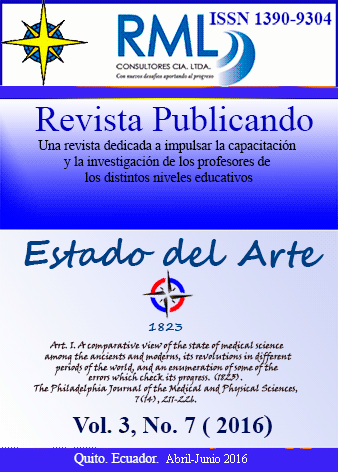Abstract
. El artículo se propuso una reflexión sobre la Contabilidad Ambiental y su desarrollo a partir de una revisión de la bibliografía al respecto y como base a una investigación en curso, en relación con poder mejorar la enseñanza de esta disciplina en los programas actuales de Contabilidad de tercer nivel. Se pudo concluir que la Contabilidad Ambiental es un campo investigativo muy activo de acuerdo con el elevado número de citas que como promedio reciben las contribuciones en ese campo, Se determinaron .los artículos más importantes, los más citados, que constituyen la base a estudiar por cualquier estudiante, o profesor que desee iniciarse en el tema.
En relación con la introducción de la Contabilidad Ambiental en los programas universitarios se estableció que es central a considerar que incorporar esta disciplina y su complejidad en el currículo, pasa necesariamente por introducir una perspectiva social y crítica en la Enseñanza de la Contabilidad.
Se resaltaron como direcciones investigativas más importantes a desarrollar sobre Contabilidad Ambiental el desarrollo de modelos que con un enfoque crítico puedan contribuir al análisis de las diferentes variables que intervienen en los procesos de la Contabilidad Ambiental, la realización de investigaciones que puedan profundizar en la relación aprendizaje y práctica de la Contabilidad Ambiental y en el carácter multidisciplinario de esta.
References
Ablan Bortone, N., Méndez Vergara, E., Bortone, N. A., et al.Vergara, E. M. (2004). Una disciplina y un campo para el conocimiento y la acción. Comisión de árbitros de este número, 7(8), 7.
Alonso, J. A. G., et al.González, Y. P. (2014). Precisión del “estado del arte”. Paso imprescindible para poder escribir un artículo para una revista indexada. Revista Publicando, 1(1), 3-7.
Alonso, J. A. G., Yánez, J. F. T., et al.Linzán, J. F. P. (2016). El marketing de guerrilla. Un estudio bibliométrico. Revista Publicando, 3(6), 471-484.
Apostolou, B., Dorminey, J. W., Hassell, J. M., et al.Rebele, J. E. (2015). Accounting education literature review (2015). Journal of Accounting Education. doi: http://dx.doi.org/10.1016/j.jaccedu.2016.03.002
Boyce, G., Greer, S., Blair, B., et al.Davids, C. (2012). Expanding the horizons of accounting education: Incorporating social and critical perspectives. Accounting Education, 21(1), 47-74.
Boyd, J., et al.Banzhaf, S. (2007). What are ecosystem services? The need for standardized environmental accounting units. Ecological Economics, 63(2), 616-626.
Brown, M. T., et al.Ulgiati, S. (2004). Emergy analysis and environmental accounting a2 - cleveland, cutler j Encyclopedia of energy (pp. 329-354). New York: Elsevier.
Chambers, R. J. (1995). 200 - the psychological and social background of accounting An accounting thesaurus (pp. 179-304). Oxford: Pergamon.
Chong, V. K., et al.Chong, K. M. (1997). Strategic choices, environmental uncertainty and sbu performance: A note on the intervening role of management accounting systems. Accounting and Business Research, 27(4), 268-276.
Fried, H. O., Lovell, C. K., Schmidt, S. S., et al.Yaisawarng, S. (2002). Accounting for environmental effects and statistical noise in data envelopment analysis. Journal of productivity Analysis, 17(1-2), 157-174.
Gray, R., Owen, D., et al.Adams, C. (1996). Accounting & accountability: Changes and challenges in corporate social and environmental reporting: Prentice Hall.
Gray, R., Owen, D., et al.Maunders, K. (1988). Corporate social reporting: Emerging trends in accountability and the social contract. Accounting, Auditing & Accountability Journal, 1(1), 6-20.
Harzing, A. W. (2008). Publish or perish.
Lehman, G. (1999). Disclosing new worlds: A role for social and environmental accounting and auditing. Accounting, Organizations and society, 24(3), 217-241.
Marriott, N., Stoner, G., Fogarty, T., et al.Sangster, A. (2014). Publishing characteristics, geographic dispersion and research traditions of recent international accounting education research. The British Accounting Review, 46(3), 264-280. doi: http://dx.doi.org/10.1016/j.bar.2013.11.003
Marshall, E. I. (2001). Business and society: Social accounting a2 - smelser, neil j. In P. B. Baltes (Ed.), International encyclopedia of the social & behavioral sciences (pp. 1418-1421). Oxford: Pergamon.
Mathews, M. (2001). Some thoughts on social and environmental accounting education. Accounting Education, 10(4), 335-352.
Mathews, M. R. (1997). Twenty-five years of social and environmental accounting research: Is there a silver jubilee to celebrate? Accounting, Auditing & Accountability Journal, 10(4), 481-531.
Odum, H. T. (1996). Environmental accounting: Wiley.
Owen, D. (2008). Chronicles of wasted time?: A personal reflection on the current state of, and future prospects for, social and environmental accounting research. Accounting, Auditing & Accountability Journal, 21, 240-267.
Salas Fuente, H. (2015). Integración de la dimensión ambiental al sistema de información financiero de empresas ubicadas en ecosistemas frágiles. Revista Universidad y Sociedad, 7(1), 102-109.
Schaltegger, S., et al.Burritt, R. (2000). Contemporary environmental accounting: Issues, concepts and practice: Greenleaf Publishing.
Vesty, G., Brooks, A., Oliver, J., et al.Bakshi, S. (2016). Chapter 22 - management accounting and biodiversity: The cultural circuit of capitalism and the social construction of a perfect market? Handbook of environmental and sustainable finance (pp. 445-470). San Diego: Academic Press.
Wang, E. C., et al.Huang, W. (2007). Relative efficiency of r&d activities: A cross-country study accounting for environmental factors in the dea approach. Research Policy, 36(2), 260-273.
You are free to:
Share — copy and redistribute the material in any medium or format.
Adapt — remix, transform, and build upon the material.
The licensor cannot revoke these freedoms as long as you follow the license terms.
Under the following terms:
Attribution — You must give appropriate credit, provide a link to the license, and indicate if changes were made. You may do so in any reasonable manner, but not in any way that suggests the licensor endorses you or your use.
NonCommercial — You may not use the material for commercial purposes.
ShareAlike — If you remix, transform, or build upon the material, you must distribute your contributions under the same license as the original.
No additional restrictions — You may not apply legal terms or technological measures that legally restrict others from doing anything the license permits.
